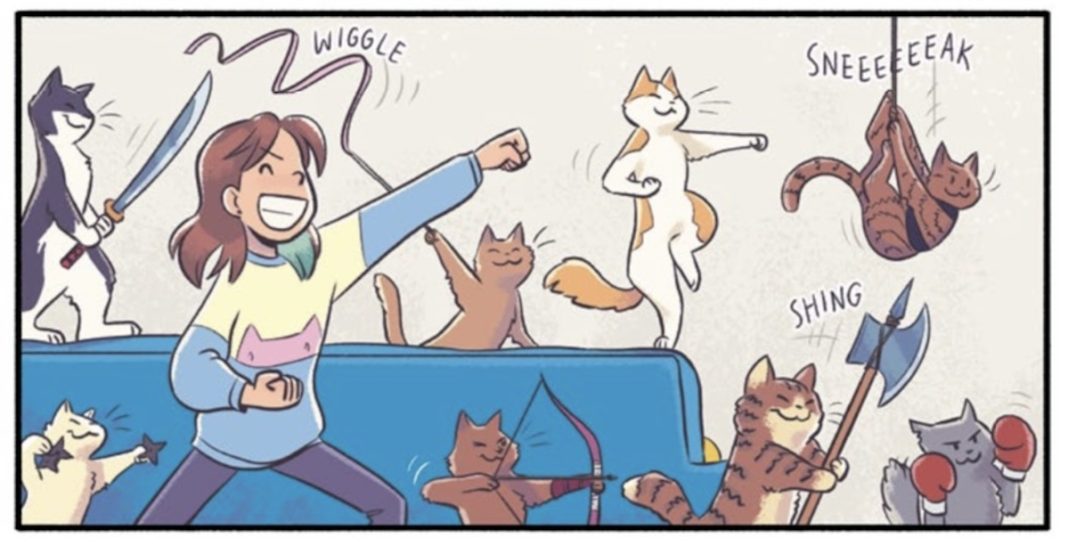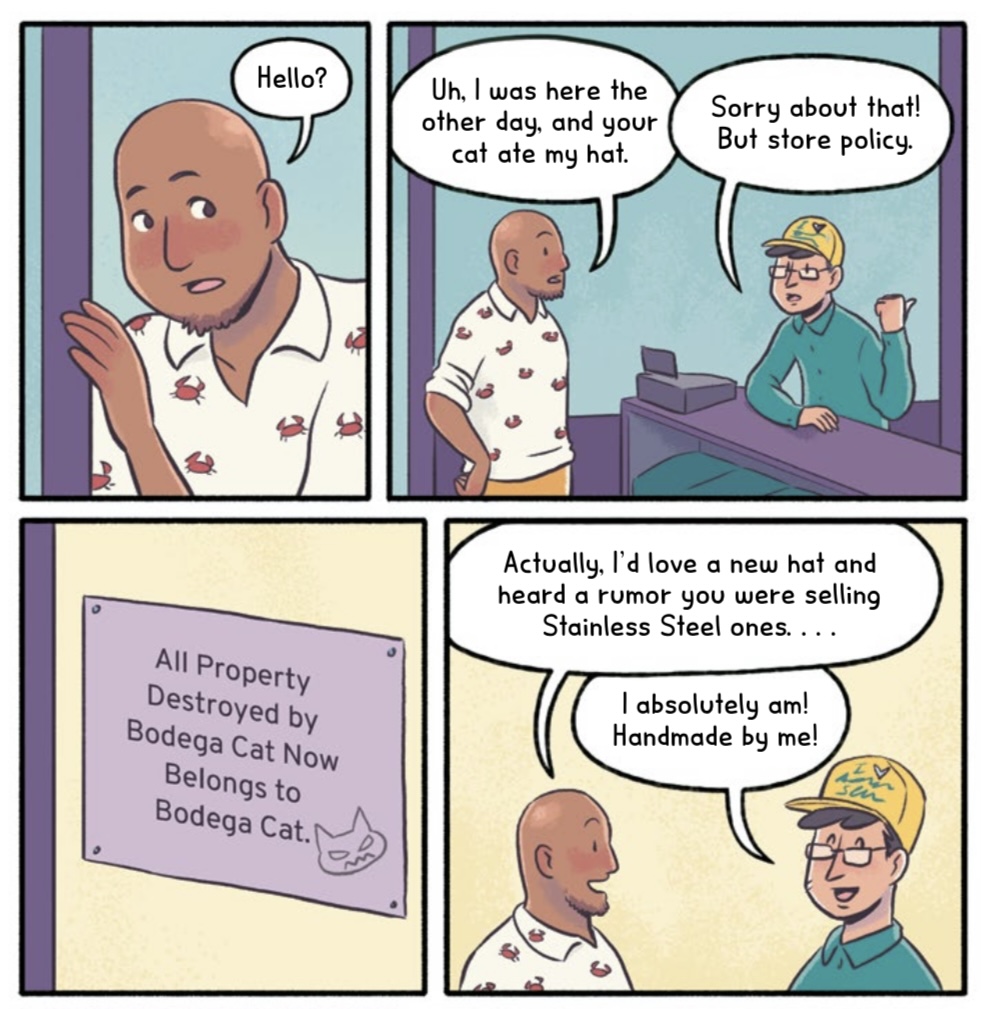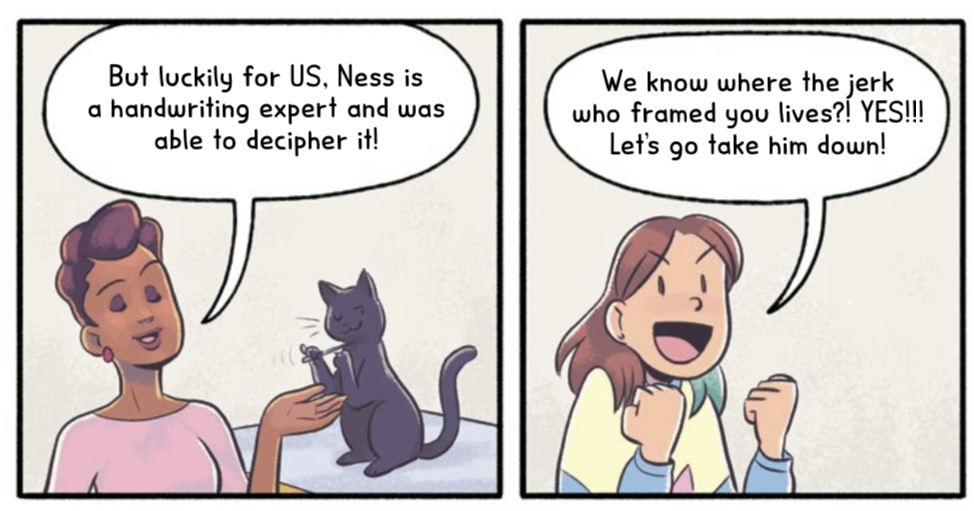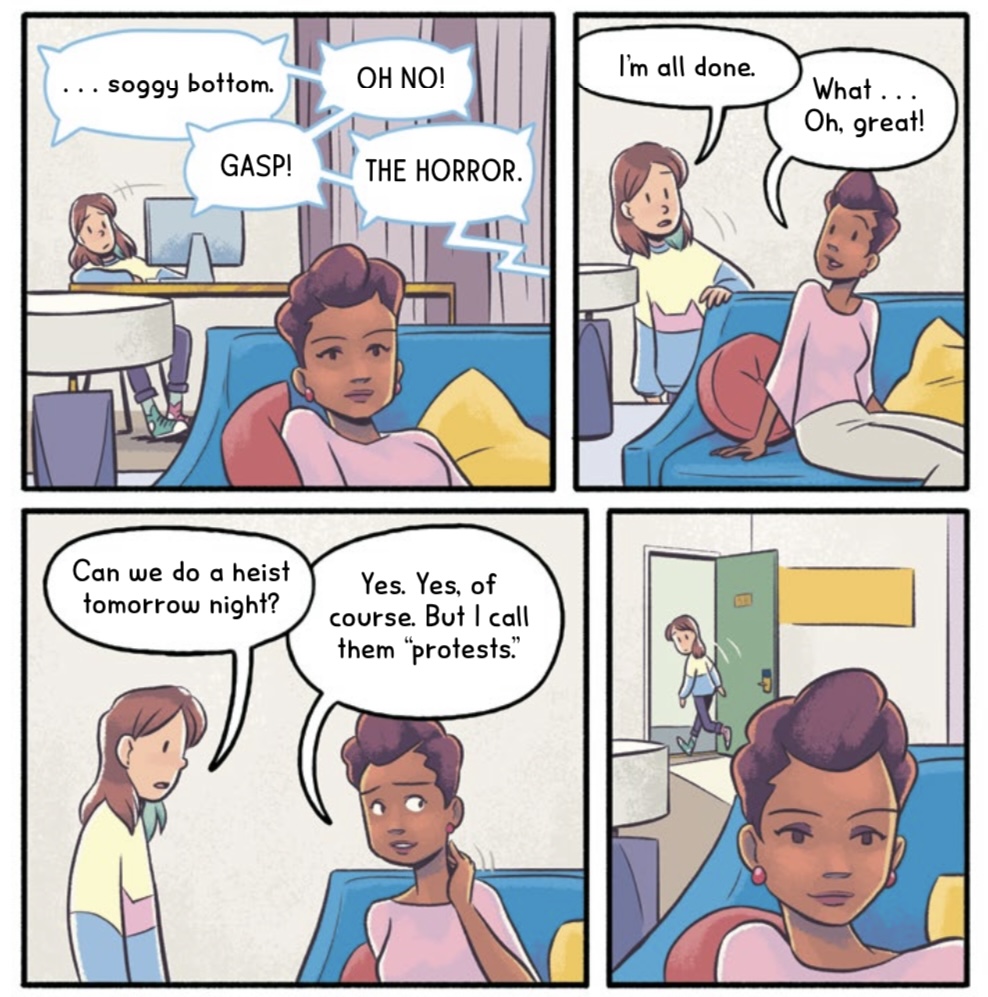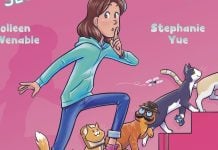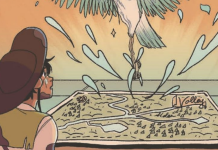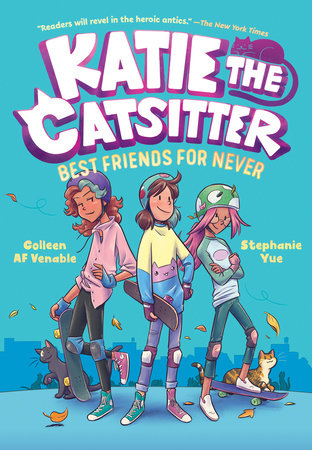
In Katie the Catsitter: Best Friends for Never by Colleen AF Venable and Stephanie Yue, with colors by Braden Lamb, the story of Katie continues as she and her friends deal with the fallout of the first graphic novel. The Mousetress is being blamed for things she definitely didn’t do, and now she’s spending all her time bingeing The Great Crumpet Showdown. On top of that, Katie’s relationship with Beth is further strained when Beth gets a boyfriend. Fortunately, there are 217 cats at hand who are ready to lend a paw (especially The Cuteness, who is here for ANY welding job).
The Beat got the chance to catch up with Venable and Yue over Zoom to ask all about the role of clothing in the seres, to find out why which character design was influenced by GLOW, and to discover why the Top 10 Hero Ranking (sponsored by Kelmount Cape Wax) is always such a boy’s club!
AVERY KAPLAN: What was it like to return to the world of Katie, Mousetress, and the 217 cats for a second story?
COLLEEN AF VENABLE: It’s really fun to return to these characters. I feel like so many times when you see friends break up or this superhero has been captured, and got out and this and that, there’s never any ramifications. There’s never any follow-up. There’s never any emotional lingering over those things. So many superheroes are so episodic and then it’s done, and everything is great.
I wanted in this book to be like, “Everything’s not great.” Mousetress is freaked out. She never got caught before. She can’t believe she got caught. She’s really dealing with something right now. The whole thing with like Katie, yes, she has a new best friend, but that’s not perfect. What about her old best friend? There’s still that friendship there. How do you figure out how to have both friends? If that’s actually something you want, it’s like you can grow apart, but you also can figure ways to come back together too if it really is a strong friendship.
I like the idea that it goes into those things you never see, which are what happens after. Chief Pardo is not in this book and you find out at the very end in the wanted villains that he’s actually wanted for helping the Mousetress get out. That’s the other thing. People are always helping a superhero get out and there’s no repercussions at all. You can’t let somebody out of jail and just pretend that you, “Whoops, don’t know how that happened, my fingerprint, twice.” That was my feeling with that.
STEPHANIE YUE: It’s nice because I think by book two for drawing, I had at a level of comfort in how to draw all of the main characters. It was just like, “Okay, yes, now I’m dialing in the most efficient way to make Katie look Katie, and her mom look mom, or Beth (or Bethany) look like Beth (or Bethany), and Marie too. All of the main characters it’s like, “Okay, yes, we’re dialing in.” I’m really glad that I made them quite in different shapes. Those are my favorite scenes to illustrate as well, when it’s just character interactions and it’s expressions, and you can get a lot of subtlety in just a few lines.
KAPLAN: Both volumes of Katie the Catsitter feature clothing, and specifically, how people bond over and relate to clothing. Was this an intentional parallel and will we see it continue in book three?
VENABLE: Yes.
YUE: Yes and yes. Definitely.
VENABLE: I was a kid that grew up without money, so it was a very intentional thing with Katie’s wardrobe that she wears the same things over and over again. She has a rotating group of shorts. She has a rotating group of overalls. We actually have it mapped out so that we make sure that it’s always like a kid that has a limited closet, as opposed to her friends that are always wearing something different.
The idea too of this like everybody starts wearing this same character shirt and Katie’s just not into it. She doesn’t want to be following everybody else. She also has her own favorite superhero. There is a lot of things about clothing, and I think twelve is an age where kids start to judge each other’s clothing. They start to notice when the kid wears the same thing more often. I definitely got made fun of a lot for wearing the same thing too often and people would joke around that I had like a Charlie Brown closet with the same thing all the time. It was really like, “I just own three shirts.”
The idea of clothing being a signal for economic status and also being a signal for peer pressure, and being a signal for growing up in a lot of ways. I think there’s a great moment too where you see how big that shirt is on Katie compared to her friend’s and it’s another sign she’s not growing up as fast as them. They’re getting relationship crazy and she’s not into that. I don’t think she’ll ever be into that secretly but that’s a side story. That’s not in this book but, yes. In terms of Steph’s clothing designs, I love everything the Mousetress wears and the goths. Oh, my gosh, the goths.
YUE: Yes. The Mousetress is actually really difficult to dress because– Now my search history has classy elegant New York City lady in the search history because I don’t know how to dress people like this so I try with the Mousetress. It’s funny because I also, I think, in the twelve to thirteen age range I had three pairs of pants and five shirts. I had a Charlie Brown closet.
I do have a running list of what Katie wears because Katie specifically, like you’re saying, I want to keep her in a very small capsule wardrobe almost. I’ve actually been recycling a number of her clothes into book three since it’s set in spring so now we start to go back towards the warmer weather clothing and away from the sweatshirts.
KAPLAN: Was it important to include a storyline that saw so many people misunderstanding or outright mischaracterizing our heroes? Is it any coincidence that this is gendered?
VENABLE: You’ll notice that in the rankings [in the back of Best Friends for Never], they’re all male. That’s a big thing that Stainless Steel finally gets into the rankings. A woman has never been in the rankings! I think it’s a lot like you ask somebody to name their favorite superhero now and they’re like, “Batman, Superman,” like, “Wolverine,” if they’re like more edgy. You never hear anybody say Wonder Woman. You definitely never hear anybody say Power Girl because people know that it’s slightly ridiculous.
The creators of these characters really stereotyped women and really made… the sexiness was always there and it was just a throwaway. I love She-Hulk as a character because she was absolutely a throwaway idea. They were like, “Why don’t we just make Hulk but she?” Then that character evolved over time with writers where they were like, “Okay, how about she’s always in control of her anger.”
It’s very much women are not seen as strong. They’re not seen as powerful still and it goes beyond women too it’s really like pushing back against the characters who you don’t really see the faces of most of the heroes, but they’re probably cis white men. All of them probably come from money. The ones we do see are that, and that’s a purposeful choice so, yes.
KAPLAN: In Best Friends For Never, there are several great scenes that saw the relationship between Katie and her mother. Was it important for you to emphasize this very lovely relationship?
VENABLE: Yes. Again, I never want there to be even this discussion of who Katie’s dad was because that’s not important. That happened earlier in their lives, why would they be talking about it now twelve years later? I really think she’s got this really great relationship with her mom where they have gone to being very much friends in a lot of ways. Then whenever her mom has to put her foot down, I think, that’s a moment of like, “Oh, man, she has to be a mom sometimes.” It’s really hard realizing that her work schedule is so difficult with having a kid. We explore this more in book three of how mom deals with this and deals with Katie becoming more independent in ways that she likes and doesn’t like.
I love stories where the adults have depth because I feel like a lot of times we get the “wah wah wah” adults from Peanuts. It’s like they don’t really exist and it’s hard to find a kid whose parents aren’t a giant part of their world either in good or bad ways. I wanted to make sure that there was that nice relationship. It’s also mirrored in the way that Stainless Steel, Mrs. Tinoco is with her daughter too, Bethany. I like adults with depth so I wanted there to be that closeness with Katie and her mom, also to be able to play with that later when her mom does have to be a little more mom.
KAPLAN: Stephanie, you previously mentioned that Mousetress has a costume that’s inspired by Bubblegum Crisis. Can you tell us about the costume inspirations for the human characters in Best Friends For Never?
YUE: It’s actually really difficult to dress characters because my tendency is, “Oh, I’ll just put them in really basic stuff,” like the stuff that I wear. Obviously, you need to make it both easy to draw but specific to the character. It has to reflect the character. Dressing Super Carl or just Carl was like okay, I actually dressed him a little bit after my own grandfather.
VENABLE: Oh, I don’t know that.
YUE: A little bit of my own grandfather and a little bit of a former Tai Chi teacher. A lot of times I’ll base characters off of people I know, actually. With the superhero designs or the sidekick designs… the sidekick designs are actually more fun because I feel like I can be a little more complete with them. Cold Hands, his hat was based off an ice bucket, like a hotel ice bucket type thing. I might’ve mentioned before, all of the sidekicks are just more fun for us because it’s like, “Yes, let’s just be ridiculous.” I want them to look like characters in Times Square but knockoffs, the knockoff version.
Costumes evolve as well, so Stainless Steel’s costume has evolved a little. Aside from just like a little bit of a Sailor Moon tiara going on, her costume was just spandex and shiny. It was pretty typical, but I wanted her to still be big and muscle-y, and super strong, and tall. I’m like, “Spandex will show that off really well.”
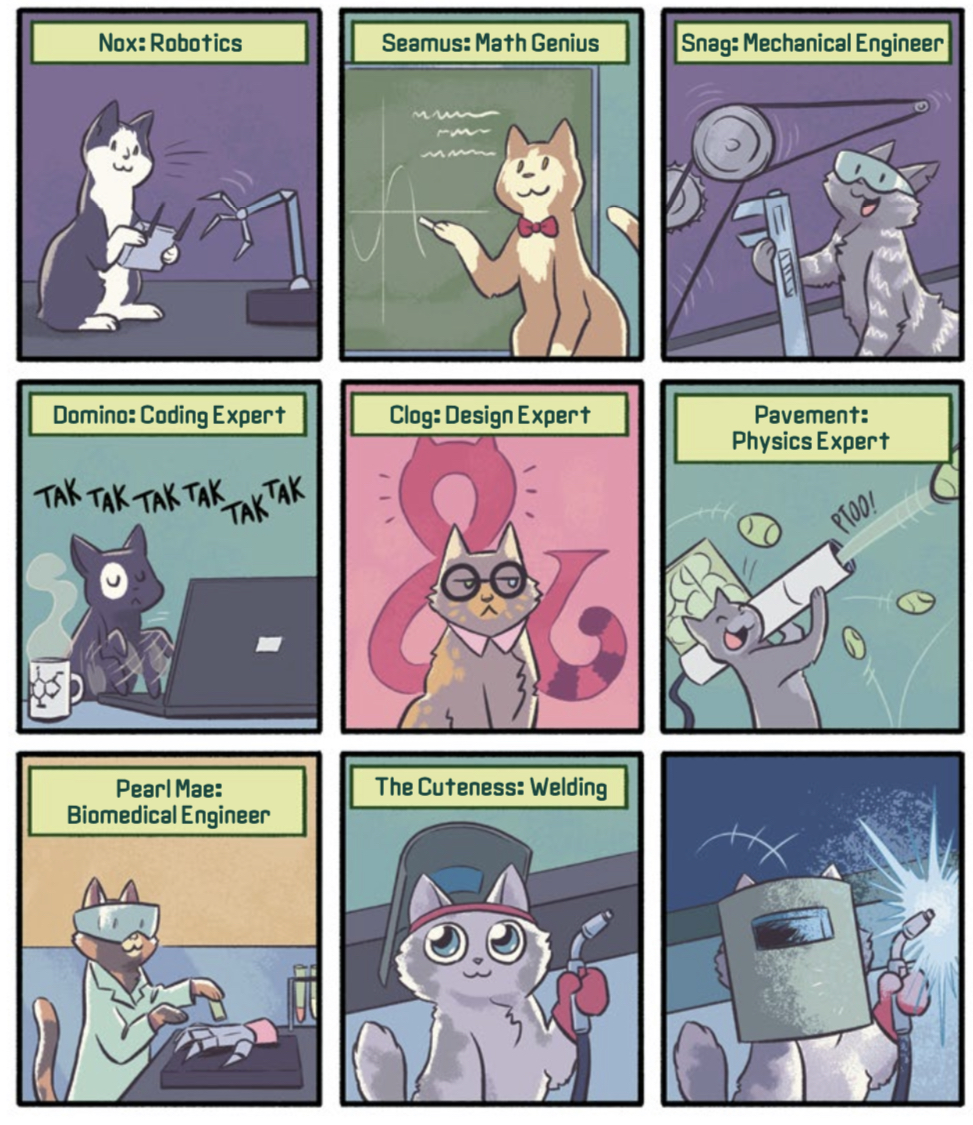
KAPLAN: Is there anything else that you’d like me to include?
VENABLE: One thing that we didn’t talk about at all was body shape, and this was a big thing for me, and with the introduction of Lupe who is very much shaped like I was as a kid. I was a very girly kid, but a very, very hyper one. It’s like seeing a kid that is a little bigger, that is just naturally a little bigger like big bones. I have giant arms. Seeing her be athletic, seeing her be super goofy and creative, making the stainless steel jacket.
The same thing with Stainless Steel, Stainless Steel should be a Roller Derby blocker. That was part of the thing we talked about. When we talked about her, it’s like she’s built like my older sister who is a Roller Derby blocker. She is a wall.
YUE: You also mentioned, was it GLOW? GLOW had just come out.
VENABLE: Yes. Oh, Mt. Fuji.
YUE: Yes. That was the other inspiration. I also wanted Stainless Steel a little bit to be like my mom because my mom also, she’s just a force. I wanted that to be depicted, that I wanted her to be physically strong as well.
The same with Lupe, I wanted skaters… I wasn’t a big kid. I was a bit of a beefy kid. I was a muscle-y kid. I hope I still have some muscles but I wanted Lupe to be athletic for sure. She’s out on the ramps, and she’s a skater, and that takes a lot. I just learned to skate ramps and it’s like, “Oh, my gosh, it’s terrifying.” It’s really, physically demanding. I wanted Lupe to also have that athleticism. Also, I want all the characters to be different shapes. It’s visually much more interesting, I think, and it’s also, I want different shapes to be represented. Marie is shaped like Katie and Nicole, who was very serious. I think in the notes it’s like she doesn’t show expression.
VENABLE: No expression, never. It doesn’t matter what. She’s like, “Wow, this is exciting.”
YUE: But she’s a softy inside. I wanted to make her tall. She’s just like shot up like bamboo.
VENABLE: You see with a lot of comic books, there’s the shorthand of drawing people a lot of times [so they all] have the same exact body shape. If you take off their hair, you wouldn’t know what character it was. I feel like that is a really amazing thing that Steph does. It’s like their faces are really distinctly shaped, that even though there’s still some of the cartooning visual things where it could be dots for eyes, they still are very emotional, and they still feel different than the character next to them. That is, I think, one of the things Steph does best is being able to get these characters all feel like they have a personality even just looking at them.
Katie the Catsitter and Katie the Catsitter: Best Friends for Never are available now at a local comic shop, bookstore, or public library near you! If you’ve had a chance to read them, give The Beat a shout-out, here in the comment section or over on social media @comicsbeat.


